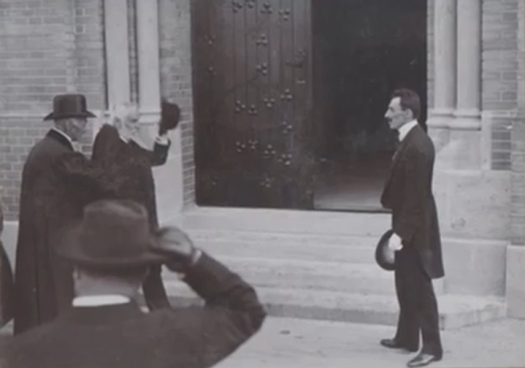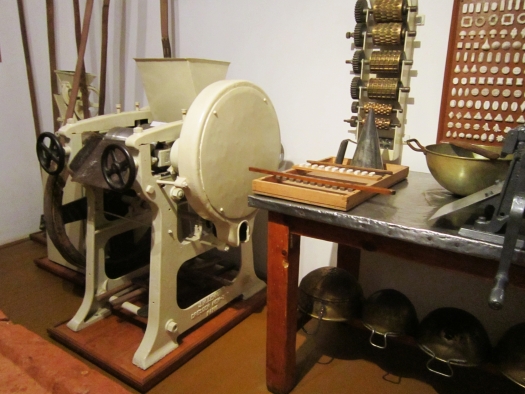Lajos Szantay, or better known as Ludovic Szantay, was born in Arad on 20th of February 1872 as son of Lajos and Theresa Szantay. He was an architect, builder and contractor who made a large number of buildings in Arad, most of them being built in Secession style, an architectural style which participates today in shaping the cultural image of the city. His family was a family of artisans, his father being a carpenter, which made him to have the culture of work “flowing in his veins”.
Szantay attended the Faculty of Architecture at the Polytechnic in Zurich between 1890 and 1895 and after those years, he followed his military service in Arad (1895-1896). The next year he went to Budapest, where he worked for three years in the office of the manufacturer Geza Majorossy and for one year in the design office of the architect Anton Hofhauser.
Shortly after being declared a member of the Hungarian Society of Decorative Art, a sad event makes Szantay return to Arad. In 1902, on the second day of November, the architect’s mother loses her life, thing which made him to return permanently to his hometown, where he opened an architecture and construction office. From that moment on, he took part “actively in the urban development of the city and its beautification until 26th July 1914, when the First World War broke outâ€, as the architect himself noted in a memorandum in 1957. In 1907 he marries Barbara Vilma Csank Rozalia, born in 1883. He worked as an architect in his own office until the beginning of the war, because then, like other young men, he was enlisted in the army. Szantay has been serving the army starting July 1914, until January 1919. Because he maintained order in the city in the postwar period, the architect was appointed as a lieutenant in the gendarmerie. Both before and after the war, Szantay was a member of the city’s municipal committee, being one of the members which examined every single architectural project of those who wanted to build something in Arad. In the same period, he was proposed (by the Principal of the Arts and Crafts School in the city) to teach lessons about technical drawing to 20 workers enrolled in a course of construction, this course aiming the improvement and enrichment of those workers knowledge in construction. Szantay mentioned in the same document written in 1957 that he did this thing pro bono (for free).

photo@arhitectura-1906.ro
He kept designing buildings and tombstones (in the Eternitatea Cemetery and in the Jewish Cemetery in Arad) until the 30’s. In the same period he obtained his Romanian Citizenship[i], this thing pushing him to take the decision to change his name from Lajos Szantay to Ludovic Szantay. Also, since 1933, he joined the Romanian Corporation of Architects.

Szantay and her daughter Theresa, in the 1930’s
After the Communist Party took the power in Romania[ii], the fame of Szantay was ignored, all his estate being confiscated (a specific action of the communist regime). Even if he would have been allowed to work as an architect, because of his age he wouldn’t have been able to get back on his feet after the state took everything he owned.
His wife dies and his daughter Anna, born in 1905, goes on a hunger strike, probably hoping to get the attention of the communists and trying to make them realize that denigrating Szantay’s contribution brought to the beauty of the city isn’t a good thing. She dies shortly after, in agony. The story says that in the last years of his life, his family had to warm up by the fire made with the architectural projects of the head of the family.
In July 1957, the architect wrote a short autobiography (describing himself as sick and old), attaching to this a list of his projects and some photographs. The document was made in order to be sent to the Romanian Architects Union, which was supposed to give him a monthly pension. Because of this document, from the autumn of the same year, he received monthly a pension which varied between 400 and 500 lei. However, the pension didn’t always arrive on time. Three years later, in the summer of 1960, Szantay made up another document just like the other one, this time adding some sketch and a few new projects to the list. This second file was intended to be sent to the same Romanian Architects Union, in order to give him a pension of merit. The request was finally validated by the Council of Ministers of the Popular Republic of Romania on 26th November 1960. Because he fit with the terms of a national ordinance written in 1959, the Romanian State had to provide him a monthly pension worth 2000 lei. Sadly, he passed away in the spring of 1961, not being able to enjoy this financial aid. The only family member who was still alive when the architect died was his daughter Theresa, born in 1915.
After the Romanian Revolution in 1989, somewhere in the downtown of the city, a street was named Ludovic Szantay. Also a commemorative plaque placed on his palace on Horia Street remembers us of Szantay.
Szantay made more than 20 significant buildings in the city and also six houses with two floors, 18 houses with one floor and eight buildings with only one lever (ground floor). Also in the first half of the 20th Century, Szantay created “41 buildings with one or two floors in Arad and 14 buildings in the Regionâ€, as noted in the same document he wrote in 1957. In the same document he mentions the intention to build a movie theater with a capacity of one thousand people at the intersection of the Central Avenue with the Crisan Street, project which wasn’t built because of the First World War.
Some of the most significant buildings designed by Ludovic Szantay are:
Kohn Palace was built in 1905; the palace is located on the Diecezanei (Diocese’s) Street no.9 and was built at the order of Josef Kohn. With an impressive floral hardware, the building fits in the geometric period of the Viennese Secession. As an interesting fact, the palace was built only after Szantay sent a second architectural plane, the first being denied by the municipality.
The Red Church is a remarkable monument belonging to the Neo gothic architectural style. The name comes from the external finishes, the building being clad in red bricks. The church was built between 1904 and 1906, after Szantay’s project won an international architecture contest. The construction of the building was also a team work between Szantay and his father, who made the carpentry of the church. At the moment of the inauguration, the church had three bells, weighting a ton and a half each, but two of them were melted during the First World War to mace ammunition.

The architect Szantay in 1906, at the inauguration of the Red Church
The Railway Station (pictured below) is one of the most impressive buildings in Arad, dominates the Railway Station’s Square and was built in 1910 after a project of a Hungarian architect, but improved by Szantay.
 
The Cultural Palace (pictured below) was from the day of its inauguration one of the most representative buildings of Arad, was built between 1911 and 1913. This building perfectly combines the Neoclassical and Baroque styles with elements of Italian Renaissance and architectural elements from the Corvin Castle in Hunedoara (Romania). It was decided at the time that the building plan be chosen through an international competition in which 27 architectural projects were received, but none of those were found right by the sponsors, so they decided to ask Szantay to design the building. The Palace was inaugurated on October 25th, 1913 and had for almost 100 years one of the best acoustics in Europe.

The Szantay Palace is one of the most characteristic secession buildings in Arad, due to the specific joinery, decorative wrought iron components and bodywork. Built between 1905 and 1911, the Szantay Palace was the residence of architect Szantay for a period in his life and one of the floors hosted the Musical Conservatory of Arad[iii] at the initiative of the architect.
The Bohus Palace (pictured below) was built in the early 20th Century by the order of Ludovic Bohus, the head of the family at that time. It was the first building in Arad built on a concrete foundation and the first one in the city to have central heating. The palace was also the first one to have an elevator and hosted one of the earliest Cinemas in the city – Cinema Studio (on the ground floor).
At the same floor had his tailor shop a tailor named Manase Ghinga, which made clothes for famous Romanian people like Stefan Banica Senior[iv], Dan Spataru[v], Ilie Nastase[vi] and Nicu Constantin[vii].

Other buildings and monuments made by Szantay: Uzina Textila Arad (Textile Factory Arad; 1923 – 1924); Grain and goods warehouse for the Central Railway Station (1925); Andrenyi Warehouse (1930); Dermatology and venereal Hospital; Former headquarters of the Chamber of Labor (1922); Lloyd Palace (1910-1911); House 80 Revolutiei Boulevard; House 90 Revolutiei Boulevard; Simay public bath house; The Palace of Arad-Cenad Bank[viii]; The Orthodox Diocesan Palace (1908); The Reformed Church on Eminescu Street[ix] (1926); The Lutheran Diocese Palace (1904-1906); House Feher; House Zoltan Szabo Baracka; Tombstones: Peter Cornett, Ludovic Papay, Nicolae Doca, Francisca Sugar Faludi (in the Eternitatea Cemetery) and the Seidner Family (in the Jewish cemetery).
NOTES
[i] Until 1918, Arad and the whole Transylvania was part of the Austro-Hungarian Empire;
[ii] The Communist Party of Romania took the power in the country in November 1946 after an electoral fraud;
[iii] Arad had the sixth Musical Conservatory in Europe and the first in the Country, founded in 1833;
[iv] Stefan Banica Senior – 1933 to 1995, a Romanian actor and singer;
[v] Dan Spataru – 1939 to 2004, a Romanian singer;
[vi] Ilie Nastase – born 1946, former world No.1 professional tennis player;
[vii] Nicu Constantin – 1938 to 2009, a Romanian actor;
[viii] The Palace of Arad-Cenad Bank – currently the Romanian National Bank’s Palace. The project is also assigned to Jozsef Hubert, an architect from Budapest, but Szantay included it in the list annexed to his autobiography sent in 1957 for his retirement. However, the building wasn’t on the list he sent in 1960;
[ix] The Reformed Church on Eminescu Street – only some changes and extensions of the building;
BIBLIOGRAPHY
- arhitectura-1906.ro – web site of the “Arhitectura” Magazine
- miscarea-aradeana.ro – web site of the Miscarea Aradeană NGO
- wikipedia.org – The Free Encyclopedia






































